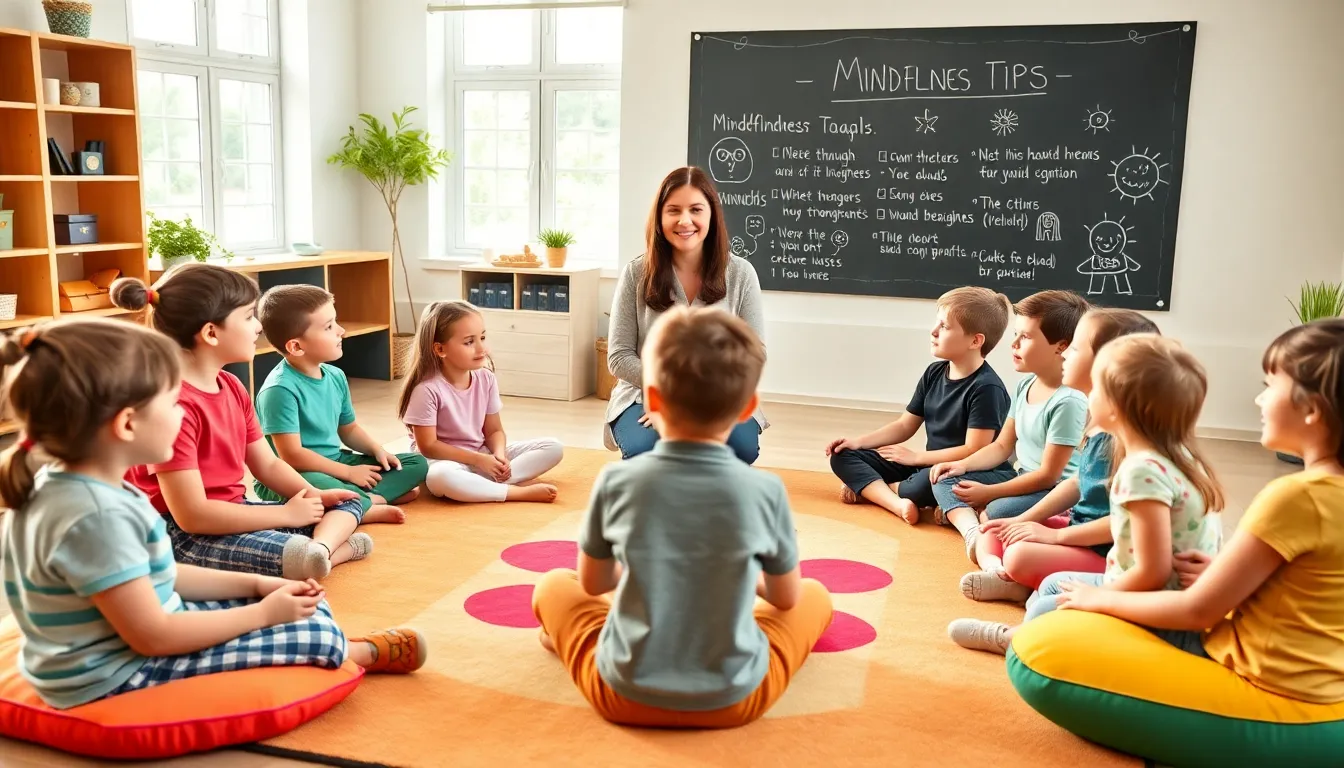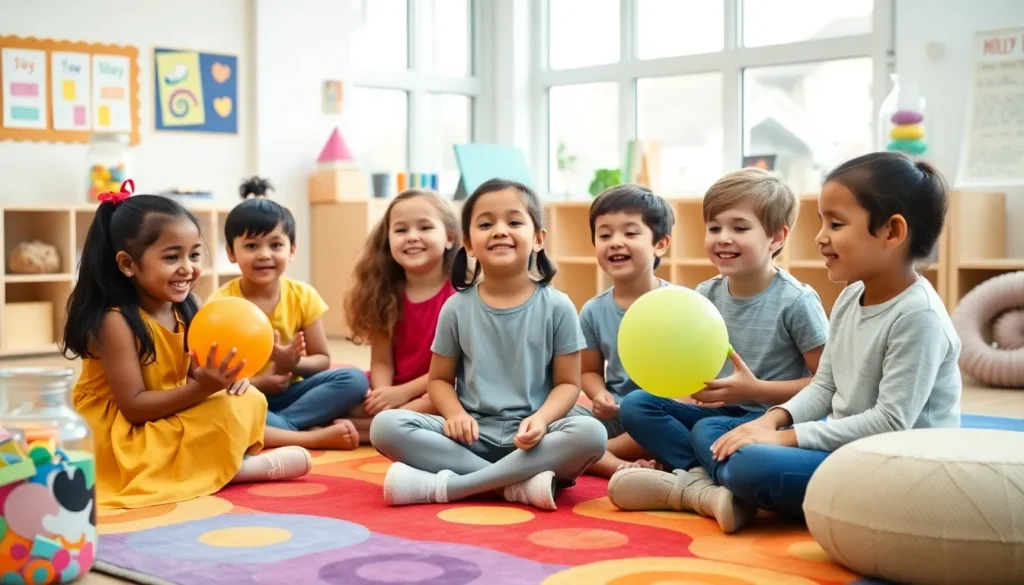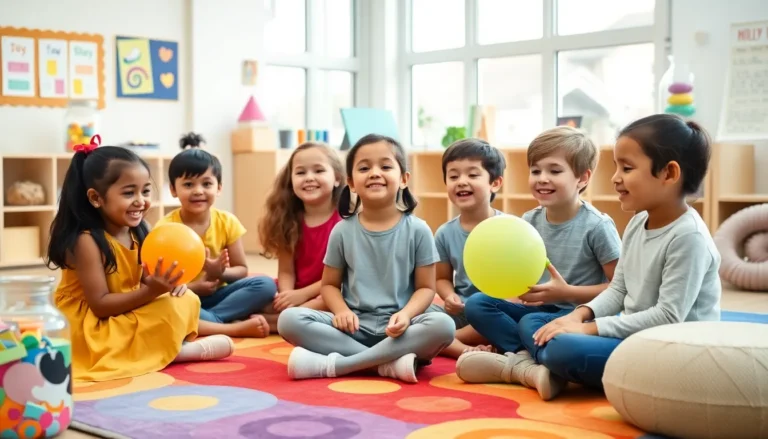Table of Contents
ToggleMindfulness isn’t just for adults sipping herbal tea and contemplating life choices. Nope. It can be a game-changing experience for kids too. Imagine a world where children learn to focus, manage their emotions, and find calm amid chaos, all while having fun. Mindfulness games for kids are like secret agents of peace, working behind the scenes to boost emotional intelligence and resilience. So, ready to jump into a joyful journey of mindful play? Let’s explore.
Benefits Of Mindfulness For Children

Mindfulness offers a treasure trove of benefits for children. Firstly, it enhances their focus and attention. With the constant barrage of stimuli in today’s world, kids can often feel overwhelmed. Mindfulness helps them to quiet their minds, allowing for better concentration on schoolwork and activities.
Secondly, practicing mindfulness can significantly reduce anxiety and stress. Children deal with various pressures, from exams to social interactions. By encouraging them to take a step back and breathe, mindfulness equips kids with tools to manage their emotions effectively.
Also, mindfulness promotes self-awareness. It encourages kids to recognize their feelings and thoughts without judgment, allowing them to respond rather than react. This heightened self-awareness can lead to improved relationships with peers, as children learn empathy and understanding.
Finally, engaging in mindfulness enhances creativity. When children disconnect from their busy lives, they open the door to imaginative thinking and problem-solving. All these benefits make mindfulness a vital skill set for today’s youth.
Types Of Mindfulness Games
Mindfulness games come in various flavors, each designed to engage youth in unique ways. One popular type is breathing games. For instance, the ‘Balloon Breathing’ game teaches kids to inhale deeply and feel their bellies expand like a balloon before exhaling slowly. This not only calms their minds but also brings awareness to their breathing.
Another type includes movement games, such as yoga or mindful walking. Children can explore their bodies and surroundings, helping them ground themselves in the present moment. Games like ‘Mindful Freeze,’ where they freeze in interesting positions after hearing a specific cue, can also mix movement with pauses for mindfulness.
Then we have creative games like ‘Mindful Coloring.’ This exercise invites kids to color mandalas while focusing solely on the colors and shapes, enabling them to immerse in creativity without distractions. Each type of game serves a purpose, fostering fun while teaching mindfulness.
Simple Mindfulness Techniques For Kids
Implementing simple mindfulness techniques can be a breeze. One technique is the ‘5-4-3-2-1′ method. This involves identifying five things they can see, four things they can touch, three things they can hear, two things they can smell, and one thing they can taste. This exercise helps ground children in their environments, enhancing their sensory awareness.
Another effective method is ‘Mindful Listening.’ In this activity, kids sit quietly and listen intently to sounds around them. It could be birds chirping or the hum of a fan. This practice sharpens their listening skills while promoting calmness.
Also, incorporating gratitude exercises can significantly boost positivity. Encourage kids to jot down three things they are thankful for every day. This technique cultivates a mindset of appreciation, helping them focus on the positive in their lives.
Creative Mindfulness Activities
Creative mindfulness activities are all about blending mindfulness with imaginative expression. One fantastic activity is ‘Mindful Storytelling.’ In this, children create stories while staying focused on the physical sensations and feelings each character experiences. This way, they engage both creativity and mindfulness simultaneously.
Another engaging activity is ‘Nature Scavenger Hunts.’ Kids can venture outdoors with a list of items to find while remaining mindful of their surroundings. For instance, they might look for a specific leaf shape or the color of a flower. This game not only promotes mindfulness but also invites them to connect with nature.
Art projects can also be a hit. Children can engage in painting or crafting without the pressure of a final product. Giving them freedom to express themselves while focusing on the enjoyment of the process fosters mindfulness in a fun way.
Mindfulness Apps And Resources
In today’s digital age, tech can assist in teaching mindfulness practices. Various apps cater to kids and families alike. ‘Headspace for Kids’ offers guided meditations tailored for different age groups, making mindfulness accessible and enjoyable.
Similarly, ‘Calm’ provides engaging stories, breathing exercises, and meditations designed specifically for young users. Both of these platforms encourage mindfulness through interactive methods, ensuring kids stay engaged while learning valuable skills.
Besides apps, parents and educators can find numerous resources online, including websites that recommend mindfulness games and activities, instructional videos, and articles. These resources serve as supplemental tools to enhance awareness and foster a stimulating environment for practicing mindfulness.
How To Incorporate Mindfulness Into Daily Routines
Incorporating mindfulness into daily routines can be engaging and straightforward. For starters, establishing a ‘Mindfulness Minute’ can be beneficial. Every day at a designated time, whether it’s after breakfast or before bed, children can spend one minute practicing deep breathing or reflecting on their day.
Parents can also model mindfulness themselves. Demonstrating practices like meditation or even just taking a moment to breathe during a busy day shows kids that mindfulness is essential for everyone. Engaging in family activities focused on mindfulness, such as nature walks or yoga, can strengthen family bonds while promoting collective mindfulness.
Finally, keeping a mindfulness jar can serve as a visual reminder. Fill a jar with notes of simple mindfulness practices or affirmations to pull out whenever family members need a moment of calm. This can anchor daily mindfulness into the family’s rhythm.








